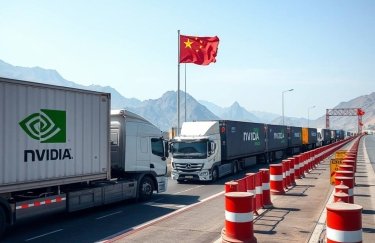
Vyacheslav Chernyakhovsky
Chief Executive Officer of the Insurance Business Association
The auto insurance landscape in Ukraine is steadily expanding. The quantity of agreements finalized is on the rise. Nevertheless, it’s premature to suggest considerable progress in this domain.
Current Standing of the Motor Third Party Liability Insurance Market
During the previous year, 2024, the volume of the motor third party liability insurance market experienced a surge of 26%, surpassing UAH 11 billion. The tally of executed contracts saw an uptick. However, lamentably, we cannot affirm substantial advancement in this sector.
Let's examine the metrics pertaining to the quantity of insurance agreements concluded monthly in recent times.

The surge in the quantity of contracts is partly “mechanical” – during December 2024, in excess of 420 thousand vehicle proprietors additionally entered into agreements “ahead of schedule” before the enactment of the novel legislation “On OSCPV”, given the widespread comprehension that its stipulations would precipitate a notable surge in rates, prompting individuals to finalize contracts at the “previous”, comparatively low costs. This resulted in a 64% swell in the number of contracts during December 2024 – surpassing 1 million contracts per month. This transient circumstance instigated a 9% decline in the count of contracts executed during the 1st trimester of 2025.
Regarding the metric of insurance premium volume, its evaluation should not be divorced from inflation, which, according to official data solely (as per the State Statistics Service of Ukraine), reached 12% for 2024. Authentic inflation, in my perspective, is steeper. Should we recalibrate the premium indicator in accordance with the official inflation metric, the augmentation in remittances is no longer striking, totaling 12.5%.

Vehicle Insurance Constitutes Above 50% of the Market
The principal rationale is Ukraine’s status as a rather impoverished nation, characterized by a constricted inventory of items available for insurance and the existence of adequate demand for them. Analogous to other comparatively deprived European nations, a notable fraction of insurance premiums originates from obligatory categories, chiefly MTPL and Green Card.
This phenomenon is particularly conspicuous owing to the virtual non-existence of a life insurance segment in Ukraine (encompassing a mere 11% of premiums from the aggregate volume), attributed to a prejudiced tax regime concerning corporate life insurance and a scarcity of enduring investment fund apparatuses, excluding government bonds and bank deposits.
Stemming from the determinants enumerated above, vehicle insurance naturally takes precedence within the structure of finalized contracts and premiums.
Should we scrutinize the composition of vehicle insurance, we shall observe the subsequent:
· Exclusively 6.5% of the collective quantity of insured vehicles under the OSCPV framework are insured via comprehensive insurance, whereas merely 25% of contracts are executed by individuals, with the residual representing insurance for fleets under the ownership of legal entities.
· Historically, the modest thresholds for comprehensive motor insurance fostered the acquisition of economical comprehensive motor insurance schemes boasting a circumscribed array of features . Subsequent to the enactment of the novel statute “On Comprehensive Motor Insurance”, the state of affairs shall incrementally evolve.
· Within Ukraine, juxtaposed with other nations, even those in Eastern Europe, the prevalence of new automobiles is critically attenuated, influencing both the inclination of vehicle possessors to procure comprehensive insurance and the magnitude of premiums for this insurance category. As a point of comparison, according to AUTO-Consulting, during 2024, 71.3 thousand novel automobiles were retailed in Ukraine, whereas in Poland, a nation formerly commensurate with Ukraine in terms of population, – nearly 550 thousand units were sold.
· The dynamics of the Green Card over recent years have been notably shaped by the multitude of Ukrainian refugees compelled to seek refuge abroad.
Ukrainians Place Confidence in the European Protocol
During the preceding year, the quantity of insurance indemnities disbursed and the tally of insurance claims adjudicated saw an augmentation. During 2024, 38.5% of vehicular incidents in Ukraine were resolved utilizing the Euro-protocol pertaining to vehicular incidents, denoting a 6.5% ascent relative to the antecedent year.
The escalation in insurance magnitudes and disbursement ceilings under the Europrotocol has yielded a scenario wherein the current threshold surpasses the average loss by several orders of magnitude. Roughly 90% of all insurance occurrences involving MTPL fall within its demarcations, inherently fostering heightened driver assurance and a more recurrent adoption of the Europrotocol. Presently, 43.9% of insurance instances are adjudicated via the Europrotocol.
What Ramifications Did the OSCPV Legislation Entail?
The Law “On Mandatory Civil Liability Insurance of Land Vehicle Owners”, endorsed during the prior year, exerted a more pronounced influence on the Ukrainian CPL market during 2025 as opposed to 2024, save for the “mechanical” elevation in contract finalization during December 2024, which I alluded to earlier.
Permit me to reiterate the pivotal stipulations of this law:
· The relinquishment of “wear and tear” considerations and indemnification for the complete outlay of repairs mirrors practices extensively implemented within EU member states, alongside the abolition of deductible utilization.
· The insurer in Ukraine is mandated to execute disbursement no later than 60 days, whereas the benchmarks stipulated by the EU Motor Directive prescribe a three-month deadline.
· The disbursement ceiling under the Europrotocol has been rescinded.
· Compulsory direct adjudication has been instituted, a measure not universally implemented across the majority of EU nations.
· Certain “privileged demographic segments” of citizenry, formerly absolved of the obligation to secure a motor vehicle insurance policy, have commenced engaging in insurance contracts – MTIBU defrays their expenditures utilizing contributions derived from insurance firms.
Generally, predicated on the outcomes of the initial semester of the present year, the ensuing trends can be discerned: a substantial surge in the mean disbursement and a more than twofold increment in the mean policy tariff, which, according to our assessments, precipitated a ~10% diminution in the tally of renegotiated contracts attributable to the “price shock”, signifying that insurers underpaid in excess of UAH 1 billion in insurance payments.
What About the Surge in Insurance Sums for OSCPV?
Heightening the insured sums under compulsory civil liability insurance (CLI) in Ukraine, as mandated by Directive 2009/103/EC, is presently unfeasible, contingent upon the nation's economic and societal attributes. The trajectories of Eastern European nations, such as the Czech Republic, Poland, or Romania, evince that an expeditious escalation in liability thresholds precipitates a substantial elevation in the expense of insurance policies, potentially impeding insurance accessibility for numerous Ukrainians, notably amidst conditions of martial law and economic instability.
The National Bank of Ukraine's proposed schema for a precipitous surge in insurance magnitudes by the year 2030 (culminating in UAH 330 million for harm to life and well-being and UAH 67 million for property impairment) shall instigate a 30-40% surge in policy expenses commencing in 2027, and prospectively – up to 2-2.5 times. This development might contract insurance coverage by 15-40%, predominantly amidst socially susceptible cohorts and possessors of pre-owned vehicles, thereby amplifying the incidence of uninsured conveyances. Within Romania and Bulgaria, an analogous escalation resulted in 30% of vehicles lacking insurance, encumbering insurance funds and augmenting expenditures for all vehicle proprietors who finalized contracts.
In Ukraine, the median magnitude of property impairment is attenuated relative to that within the EU, attributable to more economical repair amenities and a more senescent fleet of vehicles (the median vehicle age being 22 years as opposed to 12 years within the EU). A mere 5% of disbursements pertain to harm inflicted upon life and well-being, whereas within EU nations, this quotient attains 30-55%. A precipitous escalation in thresholds shall compel insurance firms to enlist costly reinsurance provisions abroad, exacting an annual sum of 50-75 million euros. These costs shall devolve upon consumers, escalating the aggregate policy expense by 100-150 million euros, as well as upon the state exchequer through the indemnification of insurance disbursements to privileged categories of citizenry.
It remains pertinent to incorporate that Ukraine has maintained membership within the Green Card system for a duration exceeding 30 years. and consistently fulfills its accountabilities within this paradigm to indemnify detriments occasioned by automobiles bearing Ukrainian registration plates in vehicular incidents transpiring upon European roadways . Ergo , viewed from the vantage point of safeguarding the pecuniary equities of European motorists, the current scenario encompassing and insurance magnitudes within Ukraine lacks consequence for their well-being.
Considering the entirety of the aforementioned factors, our Association advocates for a deferment of a substantial increment in the insurance magnitudes of the OSCPV until the cessation of martial law and the stabilization of economic and societal metrics. Ukraine retains the prerogative, analogous to other Eastern European nations, to leverage the full three-year transitionary span and adapt the schema incrementally, whilst accounting for the veritable capacity of the marketplace subsequent to Ukraine's accession to the EU or during the years following the conclusion of the war.
Martial law and economic tribulations, encompassing inflation and devaluation of the hryvnia, render hasty escalations in thresholds precarious. The paramount objective should be the preservation of insurance accessibility for the citizenry and the safeguarding of stability within the insurance marketplace, necessitating a well-calibrated strategy concerning harmonization with European benchmarks.
What About Insurance Tariffs?
During the initial semester of 2025, non-life insurance premiums swelled by 41% juxtaposed with the analogous interval during the antecedent year. The surge was propelled by the determinant of motor vehicle liability insurance, which experienced a notable surge in pricing owing to the elevation in policy tariffs subsequent to the transition towards unfettered pricing.
However, should we expunge the determinants of inflation and the substantial surge in OSCPV tariffs attributable to the novel legislation, we discern an absence of marketplace expansion – remittances ascended by a mere 1%, which generally resides within the purview of statistical variance. Concurrently, throughout the years preceding the enactment of the novel legislation, OSCPV tariffs were de facto unfettered, given that the state coefficient system in force at that juncture scarcely restrained insurers from engaging in price adjustments.
Even throughout the preparatory phases of the legislation, our Association amassed statistics from a multitude of firms and, grounded upon actuarial computations, whilst accounting for all the factors that were integrated into the bill’s amendments, foretold a 2-2.2-fold surge in OSCPV tariffs upon the enactment of the novel legislation. Moreover, the actual figures recorded during the current year have comprehensively corroborated the precision of our prognostications.
Personally, I espouse the viewpoint that the tariff escalation is generally commensurate with the advantages and remunerations procured by vehicle proprietors via the novel legislation.
Tariffs were likewise swayed by the increment in the magnitude of insurance intermediaries' commissions, which are computed as a quotient of the premium magnitude, notwithstanding the novel legislation’s lack of influence upon the volume of intermediaries’ endeavors, implying the existence of a certain buffer for prospective tariff rectifications.
The ascent in premiums correlates with the amplification of disbursements, occurrences of dumping are scarcely documented; consequently, we can assert that MTPL insurers maintain steadfast stability and are positioned to honor their commitments to casualties.
Felicitously, our enterprises refrained from replicating the deleterious methodology adopted by certain entities within the Baltic nations, Romania, and the like, wherein alterations to disbursement protocols and insurance magnitudes prompted efforts to engage in dumping as a strategy to entice a broader clientele, ultimately culminating in insolvency. Insurers, on their part, despite articulating certain populist pronouncements preceding the introduction of the novel legislation, proclaiming that the tariff escalation would not surpass 30-50%, quite unequivocally and unanimously elevated tariffs by a factor of 2 or greater, enabling us to infer that they possess ample reserves to amass provisions adequate for offsetting repair expenditures in accordance with the novel regulations governing compensation for losses. Therefore, pecuniary stability is not jeopardized.
What Is the Status of the “Green Card”?
The tally of Green Card policies experienced an 8.7% contraction throughout the initial semester of 2025. Concurrently, the aggregate of insurance premiums remained nearly invariable, diminishing by 1.7%.
During the analysis of the Green Card, it warrants recognition that insurance remittances are “pegged” to the euro exchange rate, which shifted from 43.2658 to 48.7823 (a 12.8% differential) spanning from 07/01/2024 to 06/30/2025, thereby precipitating a 14.5% decline in remittances in comparable figures (adjustment for inflation yields a similar figure – 14%).
Underlying factors contributing to the contraction in the tally of Ukrainian “Green Card” contracts:
Certain Ukrainian vehicles presently situated abroad are transitioned to local registration, consequently necessitating the procurement of national MTPL policies.
Tariffs for the Ukrainian Green Card exhibit minimal differentiation by country; thus, at times, possessors of vehicles bearing Ukrainian registration are compelled to disburse a premium for the Green Card that surpasses the expense of a local MTPL policy – the variance in tariffs can attain up to 30% (according to the online aggregator Hotline Finance, the tariff for a “Green Card” policy spanning 1 year extends from 200 to 300 euros).
The surge in the hryvnia-denominated tariffs for Green Card policies, which impinged upon the aggregate magnitude of premiums.


The advent of the electronic Green Card presented a notable asset, albeit formerly (antecedent to its enactment), the policy could be secured directly prior to transiting the boundary for departure, whereas the electronic agreement must enter into force a minimum of 24 hours prior to boundary transit.
What Lies Ahead?
In my judgment, we shall observe the ensuing patterns:
· The propensity towards a contraction in the tally of Green Card agreements shall endure.
· The hull insurance domain shall not undergo substantial vicissitudes throughout the proximate year. Conversely, prospectively, with the escalation in insurance magnitudes for MTPL, the prevalence of “economical” hull insurance policies (mini-casco, “casco for no-fault incident”) shall wane.
· Casco premiums may augment owing to the dilation of features within such agreements – exemplifying supplementary coverage pertaining to war-related contingencies.
· The tally of OSCPV agreements shall “stabilize”, inter alia, attributable to the stipulation within the novel legislation mandating that vehicle possessors belonging to preferential categories must presently execute OSCPV agreements on concessionary terms (formerly, they were typically exempt from the obligation to execute such agreements).
· By the culmination of the year, all MTPL insurance agreements shall be executed electronically, potentially instigating certain impediments for pensioners, as well as vehicle possessors in localities wherein disruptions in communication and power supply transpire during agreement finalization. The principal recommendation is to effectuate this process in advance, abstaining from procrastination until the expiry of the current policy.






